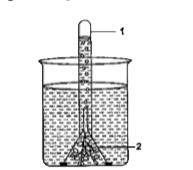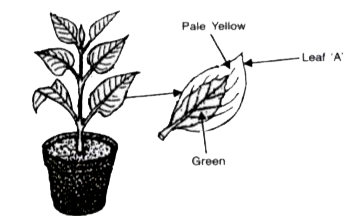Ingenhousz in an experiment showed that in bright sunlight, small bubbles were formed around the green parts of the plant, while in the dark, they did not. He identified these bubbles to be of
CO2
H2O
O2
H2
The correct Answer is:C
Step-by-Step Solution:
1. Understanding Ingenhousz's Experiment: Jan Ingenhousz conducted experiments with aquatic plants to investigate the process of photosynthesis. He observed the behavior of these plants under different lighting conditions.
2. Observation in Bright Sunlight: During his experiments, Ingenhousz noted that when the aquatic plants were exposed to bright sunlight, small bubbles formed around the green parts of the plants. This indicated some form of gas release.
3. Observation in Darkness: Ingenhousz also observed that when the same plants were kept in the dark, no bubbles were formed. This suggested that the gas release was dependent on the presence of light.
4. Identifying the Gas: Ingenhousz concluded that the bubbles produced in sunlight were not just any gas but specifically identified them as oxygen (O2). This was a significant finding as it linked the process of photosynthesis to the release of oxygen.
5. Conclusion: Ingenhousz concluded that the green parts of the plants purify the air by releasing oxygen, but this process only occurs in the presence of sunlight. Thus, the bubbles he observed were identified as oxygen.
Final Answer:
Ingenhousz identified these bubbles to be oxygen (O2).
---
Ingenhousz identified these bubbles to be oxygen (O2).
Topper's Solved these Questions
- PHOTOSYNTHESIS IN HIGHER PLANTSBook:NCERT FINGERTPS ENGLISHChapter:PHOTOSYNTHESIS IN HIGHER PLANTSExercise:Photosynthesis In Higher Plants
Explore 136 Videos
- NEURAL CONTROL AND COORDINATIONBook:NCERT FINGERTPS ENGLISHChapter:NEURAL CONTROL AND COORDINATIONExercise:All Questions
Explore 144 Videos
- PLANT GROWTH AND DEVELOPMENTBook:NCERT FINGERTPS ENGLISHChapter:PLANT GROWTH AND DEVELOPMENTExercise:Plant Growth And Development
Explore 154 Videos
Similar Questions
A potted plant with variegated leaves was taken in order to prove a factor necessary for photosynthesis. The potted plant was kept in the dark for 24 hours and then placed in bright sunlight for a few hours Observe the diagrams and answer the questions.

Why was the plant kept in the dark before beginning the experiment?
View SolutionThe following diagram demonstrates a physiological process taking place in green plants. The whole set up was placed in bright sunlight for several hours. Study the diagram and answer the questions that follow:

What would happen to the rate of bubbling of the gan if a pinch of sodiam bicarbonate is added to the water in the beaker? Explain your answer
View Solution
Knowledge Check
Empty as the man's mind was of thoughts, he was keenly observant, and he noticed the changes in the creek, the curves and bends and timber-jams, and always he sharply noted where he placed his feet. Once, coming around a bend, he shied abruptly, like a startled horse, curved away from the place where he had been walking, and retreated several paces back along the trail. The creek he knew was frozen clear to the bottom--no creek could contain water in that arctic winter--but he knew also that there were springs that bubbled out from the hillsides and ran along under the snow and on top of the ice of the creek.
What is a "creek" in this passage?AsnowBriverCtributary of the riverDpondEmpty as the man's mind was of thoughts, he was keenly observant, and he noticed the changes in the creek, the curves and bends and timber-jams, and always he sharply noted where he placed his feet. Once, coming around a bend, he shied abruptly, like a startled horse, curved away from the place where he had been walking, and retreated several paces back along the trail. The creek he knew was frozen clear to the bottom--no creek could contain water in that arctic winter--but he knew also that there were springs that bubbled out from the hillsides and ran along under the snow and on top of the ice of the creek.
What is the opposite of 'observant?ADreamyBSharpCDutifulDAspiration
The following diagram demonstrates a physiological process taking place in green plants. The whole set up was placed in bright sunlight for several hours. Study the diagram and answer the questions that follow :

Label the parts numbered 1 and 2 in the diagram.
View SolutionThe following diagram demonstrates a physiological process taking place in green plants. The whole set up was placed in bright sunlight for several hours. Study the diagram and answer the questions that follow:

Label the parts numbered 1 and 2in the diagram.
View SolutionA potted plant with variegated leaves was taken in order to prove a factor necessary for photosynthesis. The potted plant was kept in the dark for 24 hours and then placed in bright sunlight for a few hours Observe the diagrams and answer the questions.

Represent the process of photosynthesis in the form of a balanced equation
View SolutionA healthy Croton plant bearing variegated leaves was kept in a dark cupboard to destarch it after which it was placed in sunlight for a few hours. One of the leaves was then plucked and an outline of the leaf marking the green and the non-green regions was drawn. The leaf was then tested for starch. Using the above information, answer the following questions
State the aim of the above experiment.
View SolutionA tube of fine bore AB is connected to a manomeer M as shown. The stop cock S controls the flow in air. AB is dipped into a liquid whosw surface tension is σ. On opening the stop cock for a while, a bubble is formed at B and the manometer level is recorded, showing a difference h in the levels in the two arms. If ρ be the density of manometer liquid and r the radius of curvature of the bubble, then the surface tension σ of the liquid is given by

View SolutionA small aquatic plant was put in each of the petri dishes X and Y containing different culture solutions. After six weeks, the plant in dish X had the same number of leaves as earlier, and all leaves were small and yellowish. The plant in dish Y had more leaves of normal size and dark green colour. Which of the following set of elements would be missing in the culture of dish X ?
View Solution

